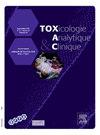Glucagon like peptide-1 analogues analysis in whole blood samples by the use of LC-ESI-HRMS method
IF 1.8
Q4 TOXICOLOGY
引用次数: 0
Abstract
Objective
The use of GLP-1 analogues has been increasing worldwide in recent years due to their benefits in treating type II diabetes. Thanks to their effects on appetite regulation, in many countries they are also used, especially semaglutide, to treat obesity. However, due to their promotion by social media and celebrities as a weight-loss treatment, GLP-1 analogues are misused by a non-diabetic and non-obese population and also by a young public, which is the main target of these media. Following the alert by the ANSM (Agence nationale de sécurité du médicament) in France and the FDA (Food and Drug Administration) in the United States, which imposed the addition of fatal effects to the list of side effects for semaglutide, the misuse seems to become a public health problem. For this reason, it seems important that a toxicology laboratory is able to evidence the presence of these drugs in blood. In this study, the authors have developed and validated a method for the identification and quantification of semaglutide and liraglutide in whole blood using a LC-HRMS method.
Methods
LC separation was achieved using a Waters Acquity HSS C18 column (150 × 2.1 × 1.8 μm) with a controlled temperature maintained at 50 °C. A 5-μL injection with a 0.25 mL/min flow of waters with 0.1% of formic acid (solvent A) and acetonitrile with 0.1% of formic acid (solvent B) was used. A Xevo G2-XS Q-TOF high-resolution mass spectrometer (Waters corporation, Milford, MA, USA) was used, operating in positive ion mode and in sensitivity mode. In MS scanning, data were acquired from 500 to 2000 m/z. For semaglutide, the 4-fold charged [M + 4H]4+ molecule was observed at m/z 1029.29752 (which deconvolutes to 4117.70139), while for liraglutide the 4-fold charged ion [M + 4H]4+ was observed at 938.76490 (which deconvolutes to 3754.53707).
The extraction was performed by blood protein precipitation using a mix of ACN/MeOH (70:30), after the addition of 50 ng/mL of internal standard (bovin insulin). The method was applied to authentic whole blood samples following a hospital request for GLP-1 analogs determination and to postmortem blood samples. The blood samples were stored at + 4 °C until analysis.
Results and discussion
Usual therapeutic blood concentrations of both drugs are in the range 50-150 ng/mL. The validation procedure demonstrated an acceptable linearity between 2 and 500 ng/mL. LOD and LOQ were 1 and 2 ng/mL, respectively. Intra and inter-day precision were below 20% at three concentrations. The method was successfully applied to the blood samples of 3 diabetic patients under treatment of semaglutide (concentrations ranged from 31 to 70 ng/mL) and to one postmortem blood sample which tested positive for liraglutide at 12 ng/mL. These concentrations fall within the limits of therapeutic blood concentrations described in the literature.
Conclusion
The use of semaglutide and liraglutide is increasing for the treatment of type II diabetes but along with its therapeutic use, its misuse for weight loss is also increasing. Because of their side effects, which can be lethal, it seems essential to be able to document an intake of these drugs. The method developed aims to highlight a therapeutic administration of semaglutide and liraglutide, to be able to also evidence the presence of traces in case of improper administration and also to ensure a forensic application on whole blood, which is the most common matrix in this field.
LC-ESI-HRMS法分析全血中胰高血糖素样肽-1类似物
目的近年来,由于GLP-1类似物在治疗II型糖尿病方面的益处,在世界范围内的应用越来越多。由于它们对食欲调节的作用,在许多国家,它们也被用于治疗肥胖,尤其是西马鲁肽。然而,由于社交媒体和名人的宣传,GLP-1类似物被非糖尿病和非肥胖人群滥用,也被年轻的公众滥用,这是这些媒体的主要目标。在法国ANSM和美国食品和药物管理局发出警告,要求在西马鲁肽的副作用清单上增加致命影响之后,滥用似乎已成为一个公共卫生问题。因此,毒理学实验室能够证明这些药物在血液中的存在似乎很重要。在这项研究中,作者开发并验证了一种使用LC-HRMS方法鉴定和定量全血中西马鲁肽和利拉鲁肽的方法。方法采用Waters Acquity HSS C18色谱柱(150 × 2.1 × 1.8 μm)进行slc分离,控制温度为50℃。采用5 μ l注射液,流速为0.25 mL/min,水溶液为0.1%甲酸(溶剂A),乙腈为0.1%甲酸(溶剂B)。使用Xevo G2-XS Q-TOF高分辨率质谱仪(Waters corporation, Milford, MA, USA),在正离子模式和灵敏度模式下工作。在MS扫描中,数据采集范围为500 ~ 2000 m/z。对于semaglutide,在M /z 1029.29752处观察到带4倍电荷的[M + 4H]4+分子(反卷至4117.70139),而对于liraglutide,在938.76490处观察到带4倍电荷的离子[M + 4H]4+(反卷至3754.53707)。在加入50 ng/mL内标(牛胰岛素)后,用ACN/MeOH(70:30)混合物进行血蛋白沉淀提取。根据医院对GLP-1类似物测定的要求,将该方法应用于真实的全血样本和死后血液样本。血样保存在+ 4°C直到分析。结果与讨论两种药物通常的治疗血药浓度在50- 150ng /mL范围内。验证程序显示在2和500 ng/mL之间具有可接受的线性关系。定量限和定量限分别为1和2 ng/mL。在三个浓度下,日内和日间精度均低于20%。该方法成功地应用于3例接受西马鲁肽(浓度范围为31 ~ 70 ng/mL)治疗的糖尿病患者的血液样本和1例死后血液样本,利拉鲁肽浓度为12 ng/mL。这些浓度在文献中描述的治疗性血药浓度范围内。结论西马鲁肽和利拉鲁肽在2型糖尿病治疗中的应用越来越多,但在治疗的同时,其误用减肥的情况也在增加。由于这些药物的副作用可能是致命的,因此能够记录这些药物的摄入似乎至关重要。开发的方法旨在突出西马鲁肽和利拉鲁肽的治疗性给药,在给药不当的情况下也能够证明痕迹的存在,并确保在全血上的法医应用,这是该领域最常见的基质。
本文章由计算机程序翻译,如有差异,请以英文原文为准。
求助全文
约1分钟内获得全文
求助全文

 求助内容:
求助内容: 应助结果提醒方式:
应助结果提醒方式:


